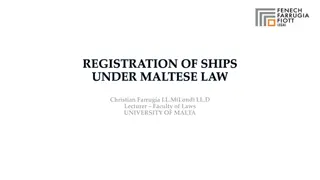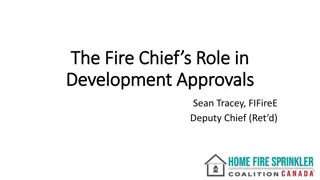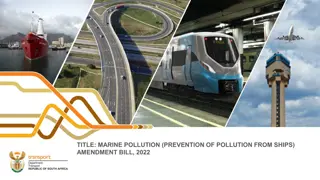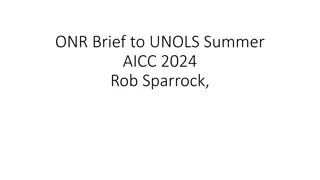Essential Firefighting Equipment on Ships
Shipboard fires are a significant risk due to high temperatures and flammable materials. To prevent and combat fires effectively, ships are equipped with fire retardant bulkheads, fire doors, fire dampers, fire pumps, fire main piping and valves, as well as fire hose and nozzles. These essential firefighting equipment and measures play a crucial role in containing and extinguishing fires to avoid catastrophic situations at sea.
Uploaded on Sep 11, 2024 | 1 Views
Download Presentation

Please find below an Image/Link to download the presentation.
The content on the website is provided AS IS for your information and personal use only. It may not be sold, licensed, or shared on other websites without obtaining consent from the author.If you encounter any issues during the download, it is possible that the publisher has removed the file from their server.
You are allowed to download the files provided on this website for personal or commercial use, subject to the condition that they are used lawfully. All files are the property of their respective owners.
The content on the website is provided AS IS for your information and personal use only. It may not be sold, licensed, or shared on other websites without obtaining consent from the author.
E N D
Presentation Transcript
FIREFIGHTING EQUIPMENT Vasilije Mijajlovic
Without doubt, one of the main causes of accidents onboard ships is fire. This is because of the presence of high temperature, excess quantity of flammable oil and other combustible materials. A ship is approved to sail in international waters only if it is constructed as per Fire Safety System code and carries required Fire Fighting Appliances approved by the concerned authority. A ship is fitted with various types of fire retardant and fire fighting equipments so as to fight any kind of fire and extinguish it as soon as possible before it turns into a major catastrophic situation. In this presentation I bring to you a list of important fire fighting equipments and measures present on board.
1. FIRE RETARDANT BULKHEAD Different Class of bulkhead such Class-A, Class-B and Class-C are used on board ship for construction of bulkhead in areas like accommodation, machinery space, pump room etc. The main applications of such bulkhead are to contain or restrict the spread of fire in sensitive areas.
1. FIRE DOORS Fire doors are fitted in fire retardant bulkhead to provide access from the same. They are self closing type doors with no hold back arrangement.
3. FIRE DAMPERS Dampers are provided in the ventilation system of cargo holds, engine room, accommodation etc. in order to block out excessive oxygen supply to the fire. For this, it is necessary that open and shut position clearly marked for fire dampers.
4. FIRE PUMPS As per regulation, a ship must have main fire pump and an emergency power pump of approved type and capacity. The location of the emergency fire pump must be outside the space where main fire pump is located.
5. FIRE MAIN PIPING AND VALVES The Fire Main piping which is connected to the main and emergency fire pump must be of approve type and capacity. Isolation and relief valves must be provided in the line to avoid over pressure of the same.
6. FIRE HOSE AND NOZZLES Fire hoses with length of at least 10 meters are used in ships. Number and diameter of the hoses are determined by the classification society. Nozzle of diameters 12 m, 16 m and 19 m used on ship are of dual purpose types- Jet and spray mode.
7. FIRE HYDRANTS Fire hoses are connected to fire hydrants from which the water supply is controlled. They are made up of heat retardant material to get least affected from the sub zero temperatures and also to ensure that hoses can be easily coupled with them.
8. PORTABLE FIRE EXTINGUISHERS Portable fire extinguishers of CO2, Foam and Dry Chemical Powder are provided in accommodation, deck and machinery spaces carried along with number of spares as given by the regulation.
9. FIXED FIRE EXTINGUISHING SYSTEM CO2, Foam and water are used in this type of system, which is installed at different locations on the ship and is remotely controlled from outside the space to be protected.
10. INERT GAS SYSTEM The inert gas system is provided in the oil tankers of 20000 dwt and above and those which are fitted with Crude oil washing. The IG system is to protect Cargo space from any fire hazards.
11. FIRE DETECTORS AND ALARMS Fire detection and alarm systems are installed in Cargo area, accommodation, deck areas, and machinery spaces along with alarm system to notify any outbreak of fire or smoke at the earliest.
12. REMOTE SHUT AND STOP SYSTEM The remote station shutdown is provided to all fuel lines from fuel oil and diesel oil tanks in the machinery space and which is done by quick closing valves. Remote stop system is also provided to stop the machineries like fuel pumps, purifier, ventilation fans, boiler etc. in the event of fire in the engine room or before discharging fixed fire fighting system in the E/R.
13. EEBD EEBD (Emergency Escape Breathing Device) is used to escape from a room on fire or filled with smoke. The location and spares of the same must be as per the requirements given in FSS code
14. FIRE FIGHTERS OUTFIT Fire fighter s outfit is used to fight a fire on the ship made up of fire retardant material of approved type. For a cargo ship at least 2 outfits and for passenger ship at least 4 outfits must be present onboard.
15. INTERNATIONAL SHORE CONNECTION (ISC) ISC is used to connect shore water to the ship system to fight fire when the ship fire pump system is not operational and is on port, lay off or dry dock. The size and dimensions are standard for all the ship and at least one coupling with gasket must be present onboard.
16. MEANS OF ESCAPE Escape routes and passages must be provided at different location of the ship along with ladders and supports leading to a safe location. The size and location are designed as per the regulation.






















